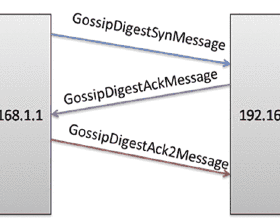We consider a fully connected network consisting of a source that maintains the current version of a file, $n$ nodes that use asynchronous gossip mechanisms to disseminate fresh information in the network, and an adversary who infects the packets at a target node through data timestamp manipulation, with the intent to replace circulation of fresh packets with outdated packets in the network. We show that a single infected node increases the expected age of a fully connected network from $O(\log n)$ to $O(n)$. Further, we show that the optimal behavior for an adversary is to reset the timestamps of all outgoing packets to the current time and of all incoming packets to an outdated time. Additionally, if the adversary allows the infected node to accept a small fraction of incoming packets from the network, then a large network can manage to curb the spread of stale files coming from the infected node and pull the network age back to $O(\log n)$. Lastly, we show that if an infected node contacts only a single node instead of all nodes of the network, the system age can still be degraded to $O(n)$. These show that fully connected nature of a network can be both a benefit and a detriment for information freshness; full connectivity, while enabling fast dissemination of information, also enables fast dissipation of adversarial inputs.
翻译:我们考虑一个完全连接的网络, 由维持当前版本文件的源、 使用非同步八卦机制在网络中传播新信息的 美元节点, 以及通过数据时间戳操作在目标节点上将包感染的对手, 目的是用网络中过时的包替换新鲜包的流通。 我们显示, 一个单一受感染的节点可以将完全连接的网络的预期年龄从O( log n) 美元提高到$O( log n) 美元。 此外, 我们显示, 一个对手的最佳行为是将所有发出的包的时标重置到当前时间, 并将所有收发的包的时标重置到一个过时的时间。 此外, 如果对手允许被感染的节点接受网络中一小部分发来的包, 那么一个大的网络可以控制从受感染节点传出的标文件的传播速度, 将网络的时代拉回到$O( log n) 。 最后, 我们显示, 如果一个被感染的节点只连接到一个单一节点, 而不是网络的所有节点, 以及所有收发包的时段, 过时的时间。 此外, 如果感染的系统能够显示, 快速传播的时代, 能够显示, 快速的系统能够显示一个快速传播的效益。




